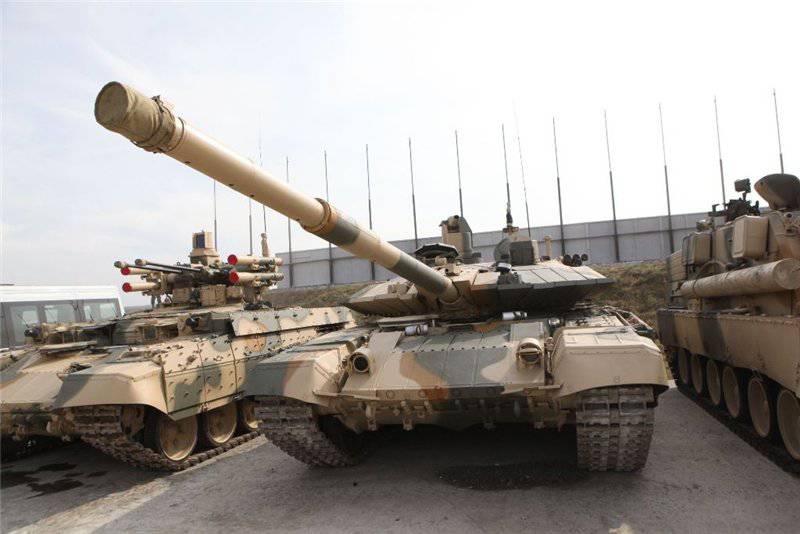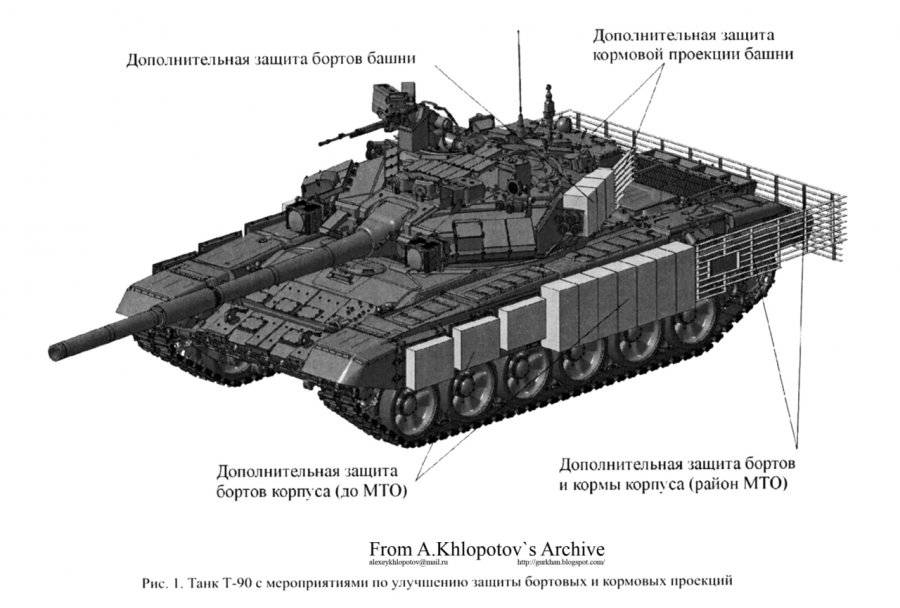Protection of onboard and stern projections of the tank from the RP

A brilliant presentation at the exhibition RUSSIAN EXPO ARMS-2011 of the new Russian tank T-90MS "Tagil" caused, among other things, a lot of questions regarding its various constructive solutions. One of the most important issues associated with this machine concerns the protection of side and aft projections. The material below is published in the collection “Actual Problems of Protection and Security”, Proceedings of the Twelfth All-Russian Scientific and Practical Conference. Volume 3. "Armored vehicles and weapons." SPB. 2009, answers some questions, explains the decisions of the designers of UKBTM. However, it must be understood that the published material is of a general, rather academic nature, and may also be subject to controversy. The solutions described in the article should not be directly transferred to the design of a specific model of armored vehicles. Yes, the T-90MS, in many respects meets the concept described here, but it also has a number of characteristic changes aimed at even greater security and protection.
The experience of local wars and armed conflicts of the last decades (North Caucasus region, Afghanistan, Iraq) shows that tank forces not only did not lose their role on the modern battlefield, but in the short term cannot be replaced by any weapon system.
High firepower and security will allow the use of tanks during military and counter-terrorist operations as an effective means of fire support. Tanks have the most, compared to other means of control, resistance to the effects of all types weapons. The high mobility of tanks allows you to quickly use the results of fire strikes.
In modern conditions it is the skillful use of tanks can largely determine the course and, as a consequence, the outcome of battles and operations. In actual combat, a tank can end up in a wide variety of situations. At present, there is a clear tendency to an ever greater shift of the center of gravity towards the confrontation of tanks and anti-tank weapons (PTS) at the line of direct fire contact with the enemy, that is, close combat. This group of PTS includes light anti-tank guided missiles and hand-held anti-tank grenade launchers (RPGs) with a range of up to 1 km, and at the same time they are the most massive anti-tank weapons. The armor-piercing ability of a variety of RPG combat units of domestic and foreign countries equipped with simple sighting devices with an effective range within 300 m is 300 ... .500 mm normal. During both the counter-terrorist operation and the breakthrough of enemy defenses, the main threat to tanks comes from infantry units, the main means of which are anti-tank grenade launchers and anti-tank systems.
The experience of combat operations during counterterrorism operations has shown the possibility of effective use of wearable anti-tank weapons, that is, hand-held anti-tank grenade launchers and light anti-tank systems. When conducting combat operations in urban conditions, in mountainous and wooded areas, the character of hits in bronzesel, including the tank, changes; that is, most defeats do not fall in the frontal projection, the most protected, but in the side and stern projections of both the hull and the turret .
In this regard, the analysis of the protection of the T-90 tank, made in UKBTM OJSC, taking into account the data on the penetration of PTS in various combat conditions and the diagrams of probabilities of hitting, shows that one of the most dangerous PTS are ATGM of various types and RPGs, and the most urgent task at this stage is to protect the side and stern projections of the T-90 tank, the protection of which has previously received insufficient attention.
This problem can be solved by installing additional blocks with elements of dynamic protection on the side projections of the hull and tower, while it is advisable to protect the stern projection with lattice screens. In fig. 1 shows the appearance of the T-90 tank, equipped with a block-modular anti-cumulative protection of the hull and turret.
To improve the security of the tank, specialists of UKBTM OJSC offer the following measures.
1. On the sides of the tower is installed on three blocks of dynamic protection on each side. The design of the blocks is similar to the dynamic protection blocks developed by the Scientific and Research Institute of Steel for lightly armored vehicles. Blocks are containers with installed elements of dynamic protection, separated by layers of filler. The blocks are permanently installed, but they are equipped with elements of dynamic protection only when tanks are used for their intended purpose, that is, on the threshold of hostilities.
2. Seven blocks of dynamic protection of a similar construction of blocks installed on the tower are installed on fences to protect the sides of the hull. Blocks are installed in places not covered by three standard on-board dynamic protection screens on each side.
3. To enhance the front area of the case, covered with standard screens of dynamic protection, an additional block of dynamic protection is attached to each screen, having smaller dimensions in thickness (stroke).
The blocks intended for installation on the sides of the hull are removable, and are equipped only in the run-up to hostilities.
4. The stern zone of the tank is protected by trellis screens, which are installed at the stern of the turret and hull.
Dynamic protection units placed on the hull, as well as lattice screens, are mounted on a tank only on the threshold of combat actions in specific conditions (for example, battles in urban conditions).
The weight of the additional protective equipment mounted on the tank will be about 1,5 tons, but given the conditions in which tanks with additional protection will be used, it can be said that this will not fundamentally affect the mobility characteristics.
It should also be noted that these measures can be implemented both in troops on T-72 and T-90 tanks, as well as during mass production. In the process of mass production, additional measures can be implemented, partially compensating for the required mass increase.
Conclusions
1. Retrofitting of T-72 and T-90 type tanks with additional protective devices on the side and stern projections can significantly increase the security of tanks from the most dangerous areas with mass use of RPGs and light ATGMs.
2. The block-modular type of protection allows, in the process of improving protective devices, on the basis of scientific and technical reserves and experimental development, to increase the level of protection against more powerful and promising cumulative means.
Literature
1. Protection of tanks. V.A. Grigoryan, E.G. Yudin, I.I. Terekhin et al .; Ed. V.A. Grigorian. -M .: Publishing House of Moscow State Technical University. N.E. Bauman, 2007.
2. Means of destruction and ammunition. A.V. Babkin, V.A. Veldanov, E.F. Gryaznov et al .; Under total ed. V.V. Selivanova. -M .: Publishing House of Moscow State Technical University. N.E. Bauman, 2008.
3. Impact force of ground forces. Equipment and weapons, 2007, No. 12.
Another fundamental point in the discussions between supporters and opponents of Russian tanks is the issue of the presence / absence of developments and designs of dynamic protection in the Russian Federation that can withstand modern tandem ammunition. Immediately answer skeptics - such protection is developed and is available. Its blocks are applied on our new tank. We plan to tell about this in more detail, but a little later.

Information